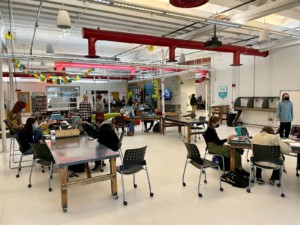Schools Can’t Innovate Until Districts Do

Robin Lake
Every sector of the U.S. economy is working on ways to deliver services in a more customized manner. In the near future, cancer treatment plans will be customized to each patient based on sophisticated genetic data and personal health histories. If all goes well, education is headed in the same direction. Personalized learning and globally benchmarked academic standards (a.k.a. Common Core) are the focus of most major school districts and charter school networks. Educators and parents know students must be better prepared to think deeply about complex problems and to have skills that are relevant for jobs that haven’t yet been created.
Promising new school models are showing what’s possible by:
- Creating adaptive daily learning plans.
- Using data to target interventions and learning opportunities for students.
- Redefining the role of teaching to focus on diagnostics and coaching rather than lecturing.
- Flexing staffing plans to meet the learning needs of students.
- Changing the definition of “school” so that students can access the best learning opportunities in their communities and globally.
- Developing, selecting, and assessing new technology-based tools to enable all of this.
But innovation in the classroom or even the school building only takes you so far. Without parallel changes in district-wide systems, efforts to support an academic sea change, like Common Core, are doomed to fail. Twenty-first century learning practices demand twenty-first century systems. Schools need to procure the best talent and tools to support their efforts and they need to be able to do so quickly. Gone should be the days when a simple request might take 12 months to implement. Gone should be the days when antiquated technology infrastructure and policies prevent schools from experimenting. Gone should be the days when a school design ends when the principal leaves. The district operating system is outdated and needs as much redesign as our schools.
In a series of papers, we’ve taken a look at the problem of system redesign from a variety of perspectives:
Released today, Next Generation School Districts goes deep into the question of which system policies are most likely to get in the way of implementing personalized learning at scale. We work outward from the school to define the new capacities and functions districts need to develop. We make the case that districts are currently unwittingly hostile to school-level innovation. For that to change, they must aggressively work to change the incentives, policies, and structures so that they encourage and free up schools to innovate.
High school redesign is one of the most elusive reform challenges to date. Next week we’ll publish The Case for Coherent High Schools, which explains why personalized high schools are hard to get and keep in a traditional school district, and shows how we can make them much more broadly available through changes in policy and philanthropic investments. Drawing from examples of successful and unsuccessful high school redesign efforts, we argue that stable leadership, school‐level autonomy, and choice for both staff and families are necessary to support high school redesign at scale.
Lastly, in Redesigning the District Operating System, we look underneath the big structural questions to the inner workings of a school district. We describe a set of interlocking, mutually reinforcing functions like procurement, contracting, data and IT policy, the general counsel’s office, human resources, and the systems for employee and family engagement. We explain how this “operating system” impedes school-level initiative and problem solving and argue for a concerted effort to redesign these critical functions, which are too often ignored in school reform conversations. Watch for this paper later in early May.
There’s a common theme that runs through each of these papers: delivering twenty-first century learning experiences at scale will take much more than just inventing interesting new school designs. If we’re serious about innovation, states and districts will need to tackle politically difficult subjects like union contracts, accountability policies, and school-level autonomies. We’ll also need to tackle some pretty boring—but essential—implementation work to replace antiquated and risk-averse central office systems and habits with nimble and updated ones. In each of these papers, we provide examples of successes and recommendations for what school leaders can do, but the first step is recognizing the work ahead.
We know the values and practices necessary for school systems to achieve much greater levels of dynamism in their problem solving. It is in our power to make these changes; so far we have simply chosen not to.
At CRPE, we’re dedicated to finding the bold, evidence-based ideas to support:
- Excellent and equitable student and family choices,
- Coherent and innovative schools, and
- Dynamic systems of schools.
These papers lay the groundwork for new ways of thinking about the intersection of these three important realms.
For more from the Center on Reinventing Public Education, check out:
- The Procurement Tightrope Shouldn’t Tie Districts in Knots
- Bringing Data to the School Enrollment Game
This blog first appeared on crpe.org.







0 Comments
Leave a Comment
Your email address will not be published. All fields are required.